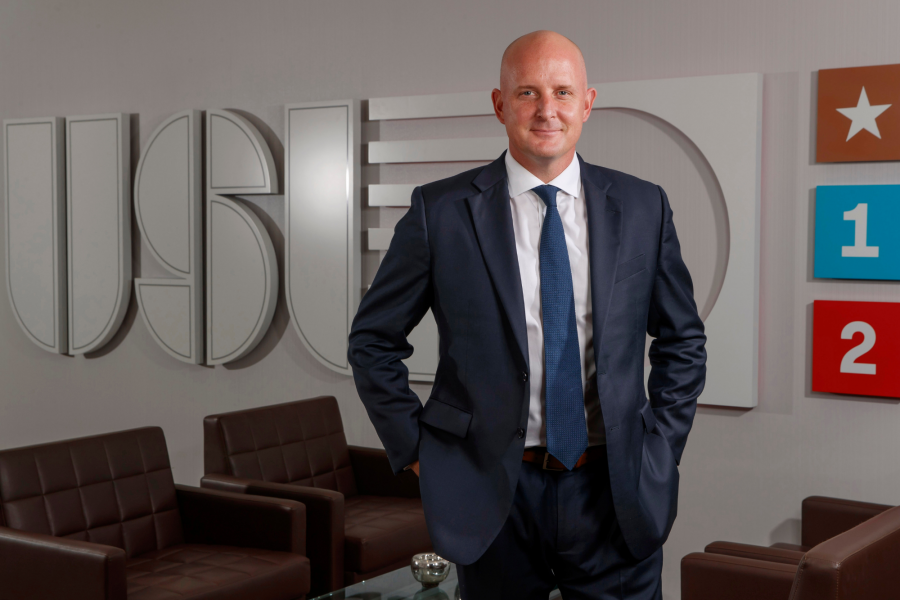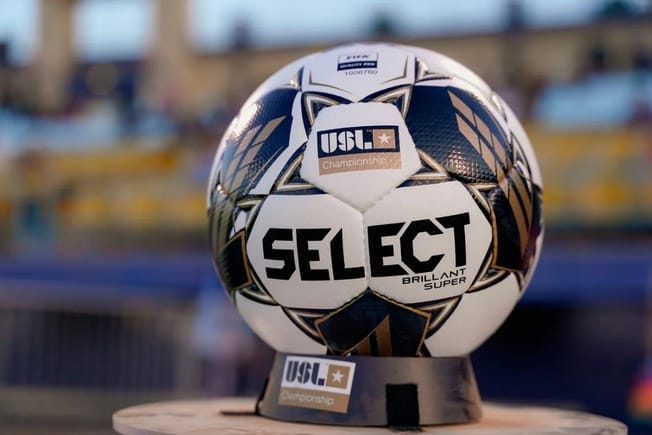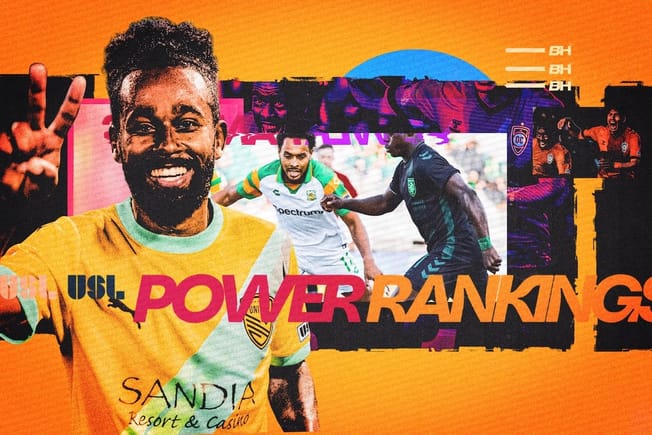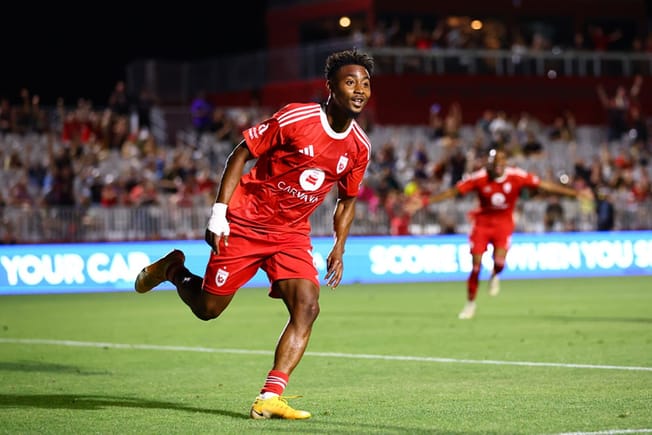As soccer continues to grow in the United States, the lower-divisions have a large part to play in the sport’s development. Recently, Backheeled sat down with a key player in the American lower-divisions: Jake Edwards. Edwards is the president of the United Soccer League, an organization that oversees the USL Championship (second division) and USL League One (third division).
In this Q&A, Edwards discusses the state of the USL, its role in American soccer, and what’s next for the Championship and League One.
This interview has been lightly edited for length and clarity,
WHAT TAKES UP MOST OF YOUR TIME AS PRESIDENT OF THE USL?
A lot of my time is spent on not just what’s happening now, but what we are doing over the next three, five, 10 years. So a lot of time spent on strategic growth initiatives for the league, both domestically and globally. I spend a lot of time with the various partners and stakeholders, be that our media partner, be that our federation, other leagues, or confederations around the world. And then, spending a lot of time with our clubs.
We have over 40 professional teams now, so there’s a lot of time I spend with our ownership, making sure they’re being serviced, they’re getting everything they need from the leagues, and they are continuing to build and grow those businesses in the right manner. I have 100+ staff here at the league office. I spend a lot of time as well making sure things here are running correctly and smoothly.
WHAT IS THE USL’S PURPOSE? WHAT HOLES IS IT FILLING RIGHT NOW IN THE AMERICAN SOCCER LANDSCAPE?
What is the purpose of the USL? It’s delivering professional football to communities and fans that don’t have access to that first touchpoint. If you don’t have a team that you can go and watch regularly, it will impact the future trajectory of the sport across the communities in this country. Think about the size of Europe, for example, and the amount of professional leagues and teams within that market.
Now, here we have a 350 million person market. We don’t have enough professional teams. And so, the purpose of USL is to bring top-level professional football to communities that don’t have access to it. Now that’s an enormous responsibility, because it’s got to be done correctly. You have to have the right people behind it, but it’s about building out the infrastructure, building out professional clubs, facilities, training grounds, academies, and building a community-based organization.
SINCE LAST YEAR, A NUMBER OF USL PLAYERS HAVE BEEN SOLD TO EUROPE. DID YOU EXPECT TO SEE THAT TREND?
We did. It was one of our key strategic initiatives that we embarked upon several years ago and it’s starting to bear results now. So this is not an overnight result, we’ve been working at this for quite some time now. We invested heavily into this at the club level and into their player development pathways. We have launched a new USL academy league, we’ve spent many years putting that together, and that’s now up and running.
We hired Mark Cartwright, a former Premier League sporting director, to come to the league office to work with our clubs on how they can start to put the infrastructure in place to get to the point where 18, 19, 20-year-old players are now going for six and seven figure deals to some of the top leagues in Europe as well as to MLS. And that’s happening both at the Championship and League One levels, so I’m very pleased with some of the more recent transfers over the last 12 months. There will be some other big announcements coming, but it is part of the concerted effort and we’re placed with where we are right now. But it’s just the beginning.
The USL to Europe pipeline is getting stronger. USYNT and former Orange County SC center back Kobi Henry is headed to Stade de Reims in France for a record fee that could rise into the “millions”.
— Backheeled (@Backheeled) June 14, 2022
More on that here, from @joeclowery.https://t.co/8Ohn7Uheu4
You’re going to see a lot more of that and it speaks to the quality that is in the league and it speaks to the awareness now that leagues and clubs around the world are getting a better perception of the quality in the USL. And our structure, as well, makes it easier for those teams to deal directly with our clubs given our clubs outright own the rights to their players.
CAN THESE TRANSFERS BE A TOOL TO HELP RAISE THE USL’S PROFILE ON A GLOBAL LEVEL?
Yeah, I think there’s a concerted effort in the USL to more closely align with the global structure of the sport. We have spent and I have spent quite some time over the last several years building those relationships internationally, educating leagues and federations around the world of the quality of the USL and the players in our league. We are seeing that now. We are seeing teams in some of the very top leagues in the world scouting our players and we are working with our teams to be ready for that. It has been a long-term strategy, and I think we will see more of that happening.
I think what it does is provide the young players that are in our academies a clear line of sight to some of the top leagues in the world. Those players in those particular communities might not have seen that path before, but now they can. And now they can go to an academy into a USL League One or a Championship team in their market, knowing that there is now a precedent for those players to start moving abroad.
IS THERE A REALIZATION AMONG INDIVIDUAL TEAMS THAT TALENT DEVELOPMENT/TRANSFERS COULD BE A REVENUE STREAM?
Yes, I think so. I think when the teams look around the league and they’re seeing other teams with players moving on for seven figure transfer fees and then additional fees beyond that, it’s natural to question “what are they doing, and how are they making that happen”? So we’re working with all of the teams to make sure they understand this opportunity. This is a nascent opportunity, this is a long game. This is not an overnight windfall. I mean you have to invest significantly into all the infrastructure needed to make this happen. And so you’ve got to think five, 10 years down the road with that investment before you start seeing the results of that.
Some of these players that are moving are coming into our academies at eight, nine, 10 years old and now they’re moving at 18, 19. So it is a long term investment and you have to understand the return on that will take a little bit of time. Teams will still obviously be focused on the main revenue drivers: ticket sales, sponsorship, merchandise, and match day revenue. But over time, this will become an important revenue stream for the clubs.
ARE MLS TEAMS STARTING TO RESPECT AND LOOK FOR THE TALENT IN THE USL?
I think so. I think USL players have been undervalued historically. Over the last several seasons, we’ve done work to set a marketplace to raise awareness and perceived value for players. And what we’ve seen historically is European clubs paying higher transfer fees than MLS clubs. Now the Diego Luna move is an interesting one. It sets the record for a USL-to-MLS move. So we are about a 280% increase now in terms of valuation of transfers from USL to MLS.
Diego Luna to MLS! Last week, Luna became the latest young USL player to move to a higher-level league. What does Luna bring to the table?
— Backheeled (@Backheeled) June 8, 2022
More on that in this episode of Today in American Soccer. pic.twitter.com/UJ7E83a9gA
We’ve seen a significant value increase in transfers from USL League One to USL Championship. So over time, the market will find its place and it’s now our job to continue to raise that market rate. That was a great move and hopefully that spurs on more MLS teams to see the real value of the players that are on the doorstep here.
YOU’VE MENTIONED PROMOTION AND RELEGATION AS A POSSIBILITY FOR THE USL. ARE THERE ANY UPDATES ON THAT?
Yes. Of course, we’ve all had COVID to deal with. But as you’ve seen recently, we have continued expansion and we have some great groups that are coming into League One over the next few years. There will be a real focus on growth and the buildout of infrastructure for us over the next few years in League One. Competition evolution and promotion/relegation and inter-league competition, all of these things are things that we’re working through at the moment to see how ultimately they drive engagement, they drive investment, and ultimately help with the popularity of the sport.
So, we’re very much focused on that. I think that is also part of looking and feeling like the global structure of the game and how to differentiate our leagues domestically and then ultimately drive value both for the fan and the club.
IS THERE A TIMELINE FOR WHEN YOU’D LIKE TO IMPLEMENT SOME STRUCTURAL CHANGES, LIKE PRO/REL, WITHIN THE USL?
Well, I think you have to do it when you’re ready and these things take a bit of time, of course. We are an innovative league, so things in some areas we can move quickly on. These are major structural changes that I think could be very impactful, so we want to make sure we get it right if we’re going to do them. So we are doing a lot of work internally and with our clubs on such changes and clubs will ultimately have to make the final decision.
We’re taking our time, we’re being thoughtful, we’re thinking about everything as much as we can. And that makes it difficult to put an exact time on when this might happen. My hope is if we’re able to make some of these changes, it would be before the World Cup in 2026 and so when the eyes of the world are on these shores, we are in a format that does look familiar to the rest of the world.
DOES THAT APPLY TO CHANGING THE CALENDAR TO FIT THE FALL-TO-SPRING INSTEAD OF THE SPRING-TO FALL SCHEDULE?
We’re doing the work on the calendar and the calendar optimization at the moment. There’s a lot to think about there and we have a lot of teams in the north. We have weather issues, so there’s a lot to consider. Ultimately, any changes that are considered have to drive value and have to be positive change.
It’s a little different when we considered the Super League. That’s starting fresh, so we are launching our women’s professional league on the international calendar from the get go. I think that’s going to be the right move for the Super League out of the gate. So League One and the Championship, you’re already in season. It’s a different proposition to start changing, but that is being looked at.
HOW MANY TEAMS WILL THE CHAMPIONSHIP AND LEAGUE ONE HAVE?
We target the Championship to remain as a two-conference league and without putting an exact number on it, somewhere in the 34, 36 range is a number that makes sense with two conferences. That’s something we’ve been at before. And as some of the teams who have left the league, predominately the MLS 2 teams, the priority then is to make sure that new teams that come on board to take us back up to that number are adding value. They are the right groups, the right communities, they’re building the right stadiums and infrastructure, so it takes a little bit of time to make sure we’ve got all of those pieces in place. New Orleans is a great example and could be a fantastic addition to the Championship.
Heading to the Crescent City ⚜️
— USL Championship (@USLChampionship) July 14, 2022
The USL has entered an exclusive partnership with @uslnola, a group dedicated to bringing a professional soccer club to Greater New Orleans.
Details ↓
League One has more room to grow than the Championship. Ideally, we’ll see if that dictates the same number of teams to mirror the Championship. That’s over the next sort of 10 years of expansion. So a lot more growth to go on League One – and I think probably somewhere in that low-to-mid 30 range makes sense for the Championship.
HOW DOES MLS NEXT PRO COMING ON THE SCENE CHANGE THINGS FOR THE USL?
I don’t know, necessarily, that it changes things for us. We have a model that we think works for League One. We’re focused on expanding into the communities who absolutely want a team of their own to take pride in and to win championships and for it to be healthy business. It’s a different model. It’s not just a player development model. So our focus on League One and what we’re trying to do with that and then ultimately connecting it up into the Championship is a different model than MLS NEXT Pro. We have almost 50 different expansion communities now that we’re in active dialogue with for League One, so there’s an incredible appetite for it.
IS THERE ANY PART OF THIS MORE FORMALIZED SEPARATION FROM MLS THAT COULD BE ADVANTAGEOUS FOR THE USL?
What we’re seeing now, in terms of an additional positive, is a lot of players in those communities choose League One teams. They’re choosing to go into those academies and into those first teams at the League One level, knowing they can move up or overseas. We’re providing, through that, another pathway and now a more proven pathway to get to the professional level and even to some of the top leagues around the world. So as we are coexisting, we’re also seeing an acceleration in the quality of the players coming into League One and moving up and abroad. I’m not seeing any negatives.
Look, I’ve always said this: more football is better for everybody.
BACK IN 2019, THE USL SIGNED A THREE-YEAR TV RIGHTS DEAL WITH ESPN. THAT DEAL IS COMING TO AN END THIS YEAR. WHAT’S NEXT FOR THE USL'S TV RIGHTS?
We’re right in the middle of that process at the moment. We’re engaged with ESPN. We’ve had great conversations across the media landscape. We’re right in the middle of renewals of our domestic media rights. We’re also working with Sport 5 on our international media rights. We have some great progress we’re making there and new territory that we’re looking at. So I think it’s been overall a very positive last few years with ESPN. We’ve had some strong growth in viewership on ESPN+, both for Championship and League One. We’ve seen over the last month two record viewership games on linear TV in Hartford and Detroit. So I know both we and ESPN have been pleased with those viewership numbers and trajectory.
We’ve also invested heavily into the media production side in USL: we’ve taken on a whole new team of top-level executives. We have Michael Cohen and Dana Rubin and are building out our really robust media department here at the league office. So a significant investment will continue into the production and the quality of the production and we hope over the next couple of months, we’ll have some announcements on the media partner for 2023 and beyond.
DOES THAT MEAN THE PLAN IS TO CONTINUE WITH ESPN?
We’re in dialogue with ESPN, yes. I know there’s a number of interested parties. ESPN is certainly one of them. They’ve been great partners to work with and we’ve really enjoyed our time together. So we’re in active dialogue with EPSN at this point in time, yes.
ARE THERE SPECIFIC GOALS YOU HAVE IN MIND WITH THIS NEW TV DEAL?
Streaming is obviously where the vast majority of our games live and I think that will be the same moving forward. We would like to increase the linear exposure on national TV. We’re working towards that. We’ve also got a large regional and local TV network infrastructure in most of our markets now, so the games are simulcast locally. I think that’s something that’s been very beneficial for us. We’d like to grow our international presence into some new territories. We have a significant number of international players now from around the world, so that helps extend the league into new territories around the world.
So we’re really just building upon what we’ve achieved over the last media deal, but no drastic departures from what we’ve been doing.
WHAT’S NEXT FOR THE USL? WHAT ARE THINGS THAT THE LEAGUE CAN DO TO DIFFERENTIATE ITSELF AND CONTINUE TO GROW?
I’ll start with the clubs. I think the clubs are working so hard to continue to make sure they are stronger and more engaged. I think they’re doing a fantastic job and off the back of that, we can continue to build the fan base. That’s a critical area of focus for us. Really, it boils down to that: building the fan base and being more relevant in more people’s lives. And being hyper-relevant in our local communities, but being more relevant to the football fan and certainly to the domestic football fans here.
When you pull back, all the strategic priorities kind of flow to that. We are building an incredible amount of stadium infrastructure across the country. We have to play in proper stadiums that show the game in the right way, that attract top-quality players, and they give the fans the experience they deserve at a football game. We have to think globally and make sure we are building awareness of our league around the world, are attractive to players around the world, and that we are an important part of the global game and the global marketplace. That’s a key focus. And we have to build commercial and media value for the league. So the league has its work to do and the teams have to do their work, as well.
But, really, it starts with being more relevant to more football fans and building that engagement locally.







Comments